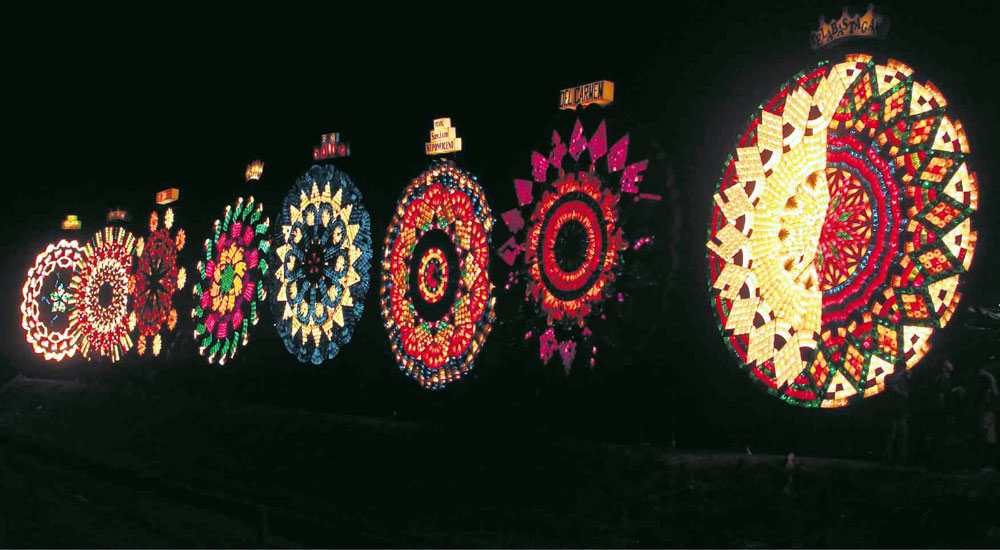10 giant lanterns inspire hope

LANTERNS OF FAITH. Giant lanterns made by craftsmen from the City of San Fernando compete in the 2013 Giant Lantern Festival in Pampanga’s capital. “Let the light speak to us of the goodness of God and these lanterns be a symbol of our deep faith in rising above adversities,” said Mariano Castro, the festival cochair. E.I. REYMOND T. OREJAS/INQUIRER CENTRAL LUZON
CITY OF SAN FERNANDO—Ten giant lanterns made by craftsmen in this capital city of Pampanga province displayed hundreds of quickly changing colorful patterns on Saturday night—which Mayor Edwin Santiago hoped would “inspire hope and [bring] prosperity to Filipinos.”
Local leaders led at least 30,000 people at the festival in a minute of silent prayer for the survivors and victims of the 7.2-magnitude earthquake in Bohol and Supertyphoon “Yolanda” in the Visayas.
“Let the lights speak to us of the goodness of God and these lanterns be a symbol of our deep faith in rising above adversities,” Mariano Castro, cochair of the Giant Lantern Festival 2013, said in Filipino before the program started on the ground of Robinsons Starmills.
Castro was referring to the 1991 eruption of Mt. Pinatubo, regarded as the world’s worst in the 20th century. The Kapampangan people battled succeeding lahar flows that destroyed agricultural lands and private property, buried people and communities, and altered the landscape of Pampanga and the nearby provinces of Tarlac and Zambales.
The making of giant lanterns started in Pampanga in 1908, with Francisco Estanislao of Barangay (village) Sta. Lucia pioneering the craft. He made lanterns, measuring 2-3 meters in diameter, from bamboo and coconut fiber.
Article continues after this advertisementModern lantern makers, however, have produced bigger lanterns, with festival entries measuring 6 meters in diameter or as tall as a two-story house.
Article continues after this advertisementBarangay Sta. Lucia used its lantern to show solidarity with the people of the Visayas before it “danced” to a Christmas medley.
It flashed the words “pagasa” (hope) and “pagbangon” (rise), and next showed the words “sama-sama” (together) and “Pasko” (Christmas) with a heart-shaped design in between.
The board of judges, which included Camarines Sur Rep. Maria Leonor “Leni” Robredo, chose Sta. Lucia’s lantern as second runner-up.
After three rounds that ended in a showdown, the night’s champion—the lantern that earned the loudest applause and cheers from the audience and which judges found to be the best in interplay of lights and music—turned out to be the entry of Barangay Telabastagan.
It obtained a near-perfect score for its unique lighting technique, the scorecards showed. Lantern maker Arnel Flores came up with entirely different designs on the two halves of his work. The effect was that the two designs lit up at the same time.
Telabastagan returned to the winner’s circle it had last occupied in 2007 and 2008.
It took 11,700 light bulbs and seven rotors for the Telabastagan lantern to deliver a flawless performance, Flores said.
A rotor is a local invention. Made of an aluminum cylinder, it is connected to the main source of electricity. All the wires to the light bulbs are connected to a bar on the cylinder using hair clips. Steering the cylinder toward the bar determines which sets of bulbs are going to be lit.
Estanislao’s grandson, Ernesto Quiwa, designed the Barangay Del Carmen lantern, adjudged first runner-up, while Quiwa’s son, Eric, designed the Sta. Lucia lantern.
The festival has its roots in the lubena (novena) or when all the images of the patron saints of the villages are taken to the church for the completion of the Christmas dawn Masses.
For Flores, making giant lanterns is a Catholic devotion. He is carrying on tradition that the lanterns are replicas of the Star of Bethlehem, which the Bible says guided the Three Kings to the manger where Jesus Christ was born.
This is why despite having to spend under P500,000 and receiving a cash prize of only P120,000, San Fernando villages insist on joining the festival, barangay leaders said.
Having finished only high school, Flores is untrained in design or electrical engineering. “I only learned from experience,” he said.
Elder craftsmen usually mentor the younger men.
Like him, his son, Mark Niño, started young. At 18, he designed the lantern of Barangay Calulut.
All 10 lanterns will be on display in villages and malls in Pampanga until January and will join the lubenas on Dec. 24 and 25 at Metropolitan Cathedral in the city proper.